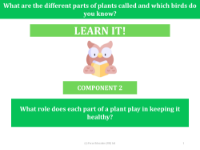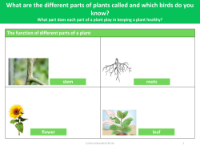What role does each part of a plant play in keeping it healthy? - Teacher's Notes

Science Resource Description
Understanding the role of each part of a plant is essential for comprehending how these living organisms survive and thrive. In an educational setting, children are encouraged to explore the different parts of a plant, namely the flower, stem, roots, and leaves. Each of these components plays a critical role in the plant's overall health and functionality. For instance, the flower is often involved in reproduction, attracting pollinators with its colors and scents. The stem serves as the plant's main support structure, also acting as a conduit for water and nutrients between the roots and leaves. The roots anchor the plant into the soil and absorb water and minerals essential for growth. Lastly, the leaves are the primary site of photosynthesis, the process by which plants convert light energy into chemical energy to fuel their growth.
To facilitate this learning, children are provided with proformas, which are structured templates that help them record and understand the functions of each plant part. By observing videos and engaging with educational content, children can visually grasp how these parts work in unison to maintain a plant's health. Questions such as "What are the different parts of plants called?" and "Which birds do you know?" encourage children to link their knowledge of plant biology with the wider ecosystem, including the role of birds in processes like seed dispersal and pollination. Through these activities, children not only learn about plant anatomy but also develop an appreciation for the interconnectivity of life on Earth.



